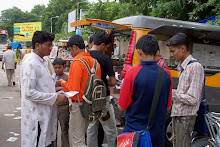A Times: Aruna Chandrshekhar: New Delhi: Wednesday, December 13, 2017.
New norms for power plants came into effect on December 7, but most power plants seem set to give them little notice.
It shouldn’t have to take a Sri Lankan cricket player throwing up in a Delhi stadium to confirm that air pollution is catastrophic in India. But it takes a particularly tone-deaf environment minister to deny that off-the-chart levels indicate a state of emergency.
“You see, what happened in Bhopal when there was a gas leak and hundreds of thousands of people fell acutely sick and had to be rushed to hospital – we call that an emergency situation, where you have to panic and you have to see what you have to do,” the minister, Dr. Harsh Vardhan, told CNN-News18 last month.The environment ministry is in no such panic, and the lack of accountability over Bhopal, 33 years after the world’s worst industrial disaster, is well documented.
At midnight on December 7, a set of progressive pollution norms that had been held up under government and industry pressure for over two years finally took effect. The new rules – issued by the Environment Ministry in 2015 and ignored by the power industry – are extremely significant for ordinary Indians. They prescribe stricter standards around emissions of particulate matter (PM), sulfur dioxide, nitrogen oxides and mercury from the burning of coal for power, and make it mandatory for power plants to install critical pollution reduction technology. The Central Pollution Control Board predicts that if enforced the new regulations could reduce particulate matter emissions by nearly 40% and sulfur and nitrogen pollution by 48%.
Overnight, as the norms took effect, more than 300 coal power plant unitsacross India were found to be in the red. Despite two years of warning to get with the program, not a single plant to date has begun retrofitting the new technology. Instead, India’s Central Electricity Authority and Ministry of Power have lobbied to allow units more breathing space – so that they will be allowed to continue violating the country’s 1986 Environment Protection Act until 2024.
Delhi alone has 13 thermal power plants inside a 300 km radius, while Chennai and Visakhapatnam have power plants barely a few kilometers from their residential centers. Other cities, such as Ahmedabad, have plants right at their core.
A government in denial
“Dr. Harsh Vardhan is a doctor – will you ban him from your association?” an irate Delhi resident asked Dr. K K Agrawal, the Chairman of the Indian Medical Association (IMA), at a press conference to remind the Environment Ministry of its obligations. The country’s premier medical organization has in fact not shied away from calling out the state of the air as a “public health emergency”.
“Somebody has to sound the alarm bell, if the government doesn’t do its job,” said Dr Agrawal, “When you allow a cricket match to be played or a new thermal power plant to be set up, you’re sending kids [the] wrong signal that the air outside is fine to play in.” Dr. Agrawal has been writing to the Olympic Association, the International Cricket Counci (ICC) and others arguing against holding sporting events in severely polluted Indian cities, and wants pollution reports to be made as important and mandatory as weather reports.
Over 135,000 citizens have signed a petition, endorsed by civil-society groups such as Jhatkaa, Greenpeace India, Help Delhi Breathe, Urja and others, that calls for an end to pollution crimes. “Power plants have failed to act on a warning that’s two years old and now want even more time to install the necessary emission reduction technology,” said Avijit Michael from the campaigning group Jhatkaa, which received shocking Right To Information (RTI) responses from power producers showing that they haven’t even begun the groundwork called for by the new rules.
“When you allow a cricket match to be played or a new thermal power plant to be set up, you’re sending kids the wrong signal that the air outside is fine to play in”
But it’s not just a case of ad-hoc urban planning in existing city-centers and “collateral damage” in industrial towns. Even new cities like Amaravati, the under-construction capital of the state of Andhra Pradesh, will violate World Health Organization (WHO) pollution standards.
“When we were arguing in court as to how Amaravati is located next to a critically polluted area like Vijayawada, we were told it was the rank lowest on the list of critical clusters. That’s like saying it’s the healthiest patient in the ICU,” says leading environmental lawyer Ritwick Dutta, who points out that health was removed as a factor for consideration in lifting bans on new industrial projects in critically-polluted areas.
While doctors like Agrawal are cautious about pollution death-toll estimates in international reports like The Lancet’s, he does acknowledge the severe lack of health data relating to pollution in the country. Under Indian law, no health impact assessments are required to expand or set up new thermal power plants. The IMA recommends all its doctors have their own pollution meters, which could add valuable data from states where even the government has no data to show. “Even if one lung is gone and two-thirds of the other severely damaged, patients may not experience breathlessness unless they exercise,” said Dr. Agrawal. “It is a duty of doctors to explain this to people who assume that unless extreme symptoms are visible, there’s nothing wrong.”
Children at risk
One of the first comprehensive Indian studies on the public health impacts of coal and thermal power comes not from Delhi but from a power-generating state without a single live air-quality monitor. In Raigarh, in the state of Chhattisgarh, researchers from Community Environmental Monitoring and the community-led Adivasi Mazdoor Sangathan found toxic heavy metals such as cadmium, arsenic and mercury in extremely high levels in air, water and soil samples.
“It was shocking to see strikingly high levels of musculoskeletal health complaints among even Adivasi (tribal) teenagers,” said Dr. Smarjit Jana, an epidemiologist from the All India Institute of Hygiene & Public Health. “These health symptoms corroborate with effects of toxic chemicals found in the environmental sampling of water, air and soil in the region.” Many of the metals are known to cause respiratory disorders, lung damage, reproductive damage, liver and kidney damage, hair loss, brittle bones, stomach pains, mental illnesses and nausea. If this is what Adivasi kids are reeling under, it’s hard to imagine what’s in store for city kids.
Responding to the furor over cricketers falling sick, the Board of Control for Cricket in India’s acting president, C K Khanna, told news agency PTI: “If 20,000 people in the stands did not have a problem and the Indian team did not face any issue, I wonder why [the] Sri Lankan team made a big fuss.”
“These health symptoms corroborate with effects of toxic chemicals found in the environmental sampling of water, air and soil in the region”
It’s another matter that air quality levels in Colombo recorded particulate matter levels 1/16th of those in Delhi on the same day. Sri Lanka, incidentally, is the only South Asian nation that has ratified the Minamata convention on mercury, with its specific mercury emission standards for coal-fired power plants. India, despite signing it on September 30, 2014, and contributing significantly to the treaty’s text, has yet to ratify it.
India’s new norms also call for reduced water usage by coal-based power plants, which are known to be notorious water guzzlers. But thanks to industry lobbying, the new limits were ‘watered down’ by 20% before their introduction. A thousand-watt power plant will still be allowed to draw excess water that could otherwise irrigate 700 hectares of land. And this in a year when the World Meteorological Organization reports that average rainfall fell by five percent, and drought worsened.
Even despite the government’s dismissive approach to international reports treaties, sporting embarrassments and protests at home, the new pollution norms are a step forward and may well prevent future pollution across the country. “Any law can only operate with citizens’ involvement,” says Ritwick Dutta. “Polluters need to be named and shamed for every unit that’s in violation,” he says. From the huge mobilization across the country, it’s clear that citizens are beginning to speak truth to power. Whether Dr. Harsh Vardhan steps up to bat for them, as the power industry and Ministry push back, will be the real litmus test.






























